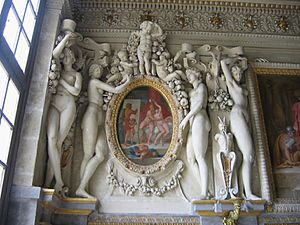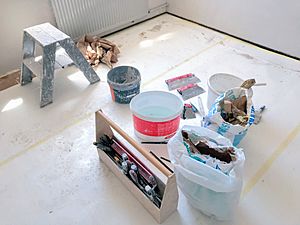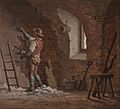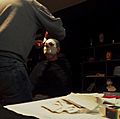Plaster facts for kids

Plaster is a common building material. People use it to cover walls and ceilings inside buildings. It makes surfaces smooth and can also be used to create beautiful decorations.
Sometimes, people use the word "render" for plaster that is used on the outside of buildings. Another word you might hear is "stucco." This often means plaster that has been shaped into cool designs that stick out from the wall, like a 3D picture.
Contents
What Plaster is Made Of
Most types of plaster are made from a dry powder. This powder usually contains gypsum, lime, or cement. Even though they are made from different things, they all work in a similar way.
When you want to use plaster, you mix the dry powder with water. This creates a thick, but easy-to-work-with, paste. As the plaster mixes with water, a chemical reaction happens. This reaction makes the plaster warm up and then it starts to harden. This hardening process is called crystallization.
How Plaster is Used
Plaster is not a super strong material, so it's not used to hold up buildings. Instead, it's great for making things look good!
- Finishing Walls: It makes walls and ceilings smooth and ready for paint or wallpaper.
- Decorations: Plaster can be shaped into many different designs. You can mold it right on the wall or make pieces ahead of time. These pre-made pieces can then be glued into place. If a plaster decoration is very thick, it might need a hidden metal frame inside to support it.
- Easy to Work With: Once plaster is dry, you can still work with it. You can use metal tools or even sandpaper to smooth it out or carve it.
Other Cool Uses for Plaster
Plaster has many uses beyond just buildings!
- In Medicine: Doctors still use plaster casts to help broken bones heal. The plaster hardens around the injured arm or leg, keeping it still.
- In Dentistry: Dentists use plaster to make molds of your teeth. This helps them create things like braces or crowns.
- For Models and Molds: Artists and creators use plaster to make all sorts of models and molds.
- In Art: For a type of painting called fresco, artists paint directly onto a thin, wet layer of lime plaster. The colors soak into the plaster, becoming part of the wall itself. In ancient times, people also made huge plaster sculptures on walls, but not many of these have lasted until today.
Images for kids
-
An orthopedic cast made from plaster, used to help a broken hand heal.
-
The famous Himeji Castle in Japan uses plaster in its construction.
-
Applying a plaster bandage to make a mold of a face.
-
Plasterwork found in the ancient city of Pompeii, from 79 AD.
-
A plaster statue of Voltaire from 1778, made to look like terracotta.
-
A plaster sculpture called "The Young Mother" by Bessie Potter Vonnoh, from around 1896.
See also
 In Spanish: Yeso para niños
In Spanish: Yeso para niños

















